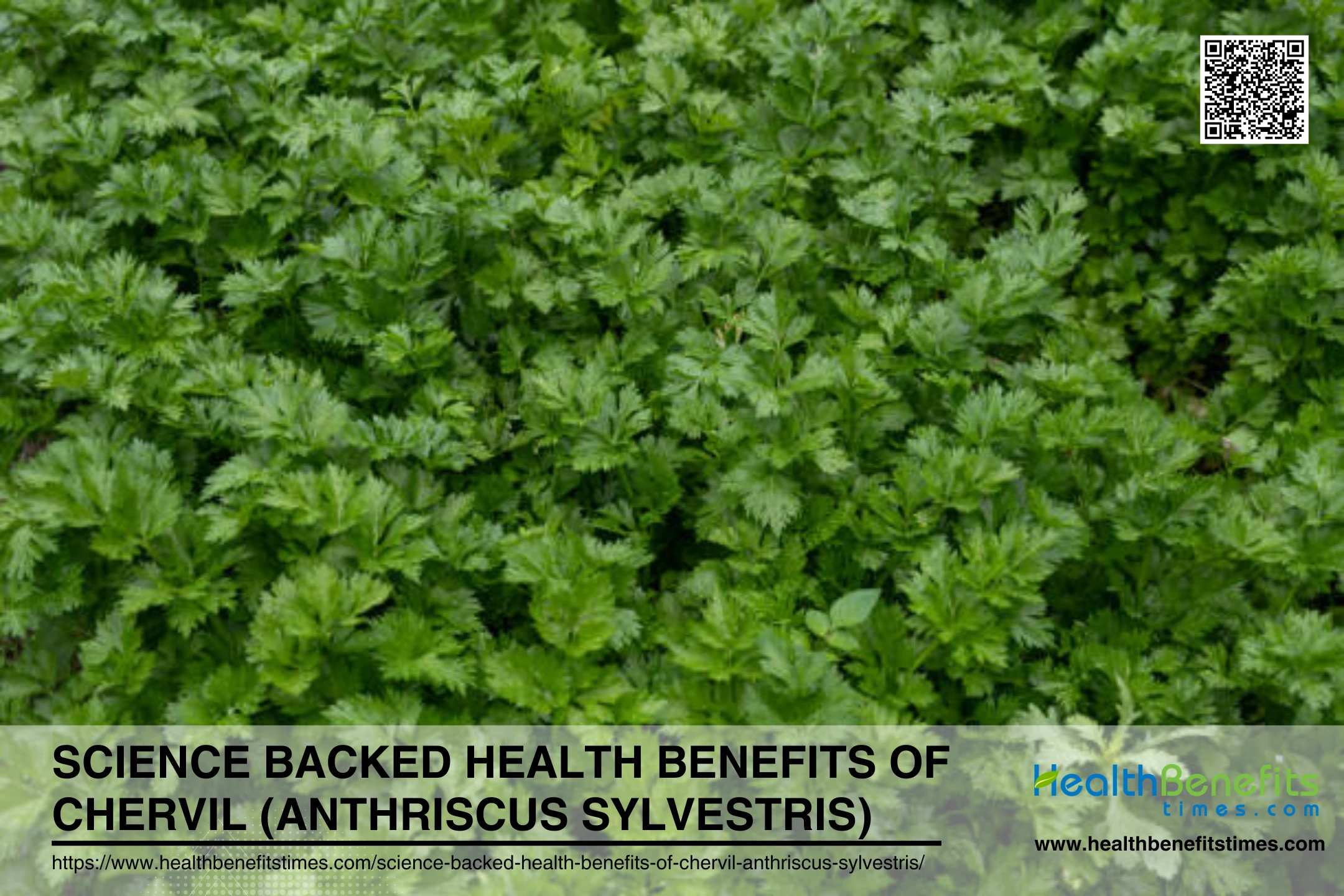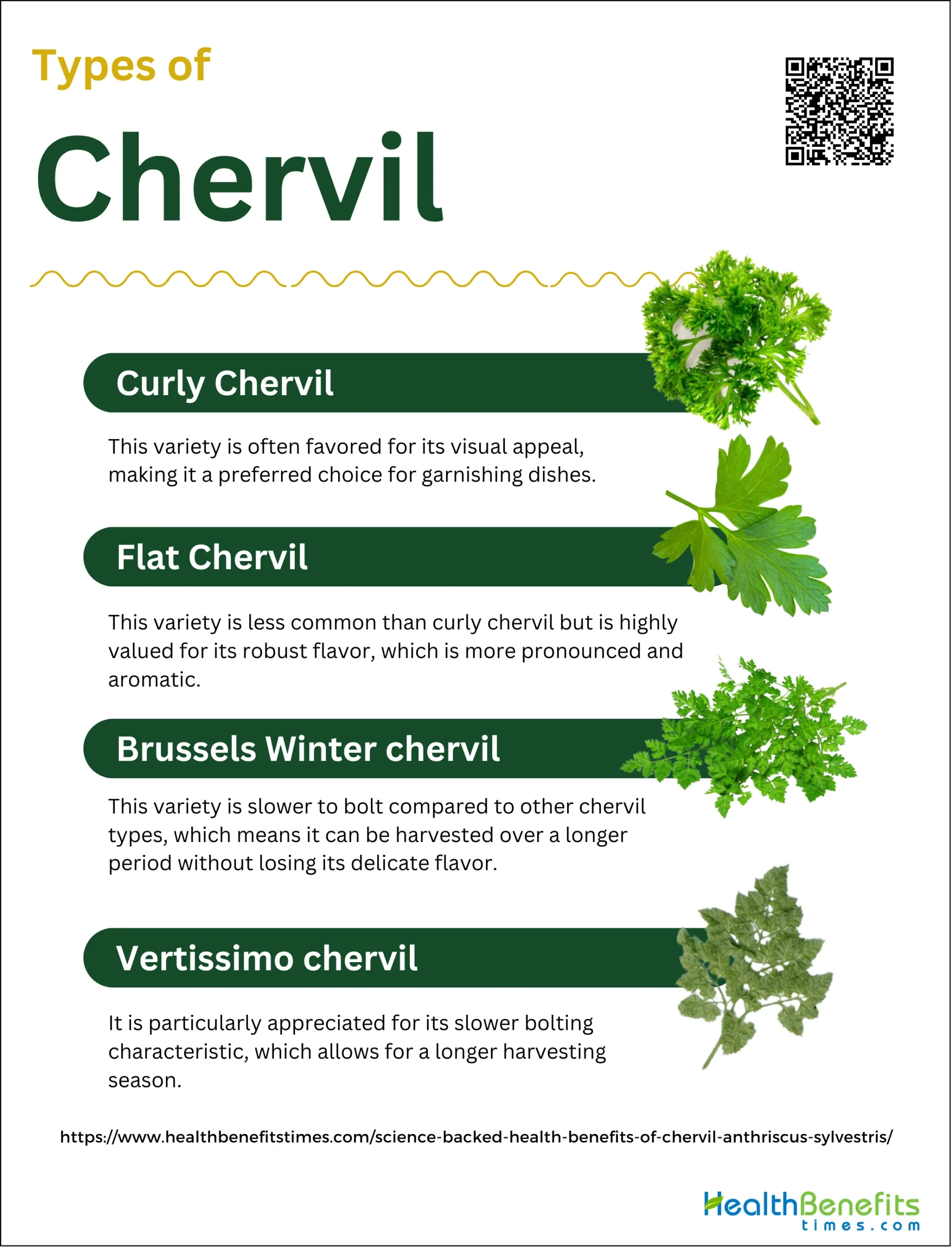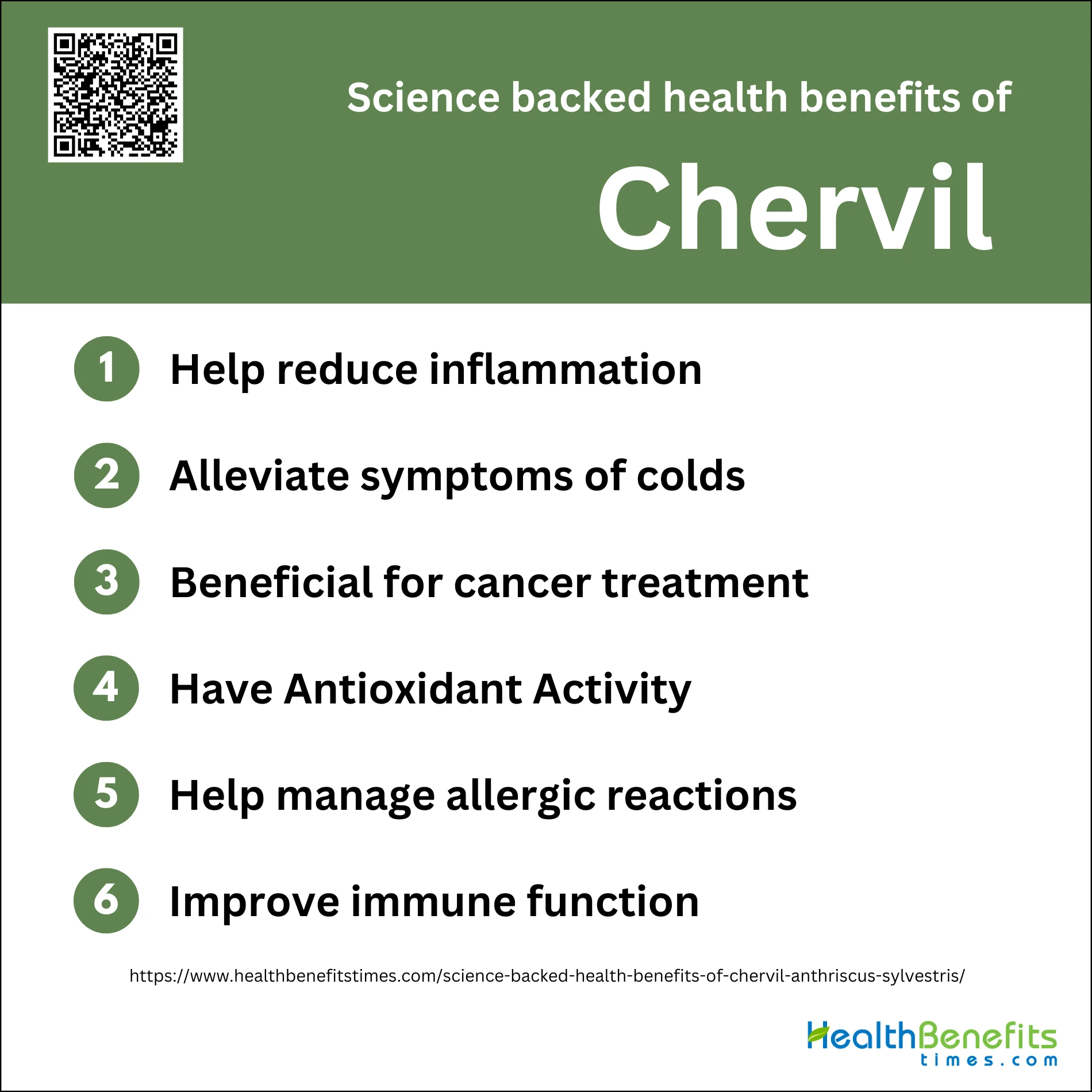- Chervil is nutrient-dense, antioxidant-rich, with significant vitamins, minerals, and benefits.
- Popular chervil varieties are Curly, Flat, Brussel’s Winter, Vertissimo, each unique.
- Chervil reduces inflammation, alleviates cold symptoms, aids cancer treatment, boosts health.
- Chervil has Antioxidant activity, reduces allergic reactions, improves immune function.
- Incorporate chervil for enhanced flavor, health benefits, versatile culinary uses.
- Chervil is generally safe but may cause allergies, gastrointestinal issues, interactions.
 Chervil, scientifically known as Anthriscus sylvestris, is more than just a delicate herb used in French cuisine. This member of the parsley family has a long history of medicinal use, backed by scientific studies highlighting its numerous health benefits. Rich in essential vitamins, minerals, and potent antioxidants, chervil offers a variety of therapeutic properties. From promoting digestion and reducing inflammation to supporting cardiovascular health and boosting the immune system, chervil’s bioactive compounds make it a valuable addition to both culinary and medicinal practices. This article delves into the science-backed health benefits of chervil, shedding light on why this herb deserves a spot in your diet and wellness routine.
Chervil, scientifically known as Anthriscus sylvestris, is more than just a delicate herb used in French cuisine. This member of the parsley family has a long history of medicinal use, backed by scientific studies highlighting its numerous health benefits. Rich in essential vitamins, minerals, and potent antioxidants, chervil offers a variety of therapeutic properties. From promoting digestion and reducing inflammation to supporting cardiovascular health and boosting the immune system, chervil’s bioactive compounds make it a valuable addition to both culinary and medicinal practices. This article delves into the science-backed health benefits of chervil, shedding light on why this herb deserves a spot in your diet and wellness routine.
What is Chervil ?
Chervil is a herbaceous plant belonging to the Apiaceae family. It is widely distributed across Europe and Asia and has naturalized in parts of North America, particularly in eastern Canada and the Pacific Northwest. This plant is notable for its high content of lignans, such as deoxypodophyllotoxin, which have significant biological activities including anti-inflammatory, antiproliferative, and antiviral properties. Wild chervil is a short-lived perennial that reproduces both by seed and vegetative budding from the root crown, often forming dense populations that can outcompete other vegetation. It has been studied for its potential as a functional food due to its nutritional components, including ascorbic acid, polyphenols, and flavonoids, which contribute to its antioxidant activity. Additionally, wild chervil has been investigated for its potential in industrial applications, particularly for the isolation of lignans related to podophyllotoxin, which are precursors for anticancer drugs. Effective management strategies for controlling its invasive spread include a combination of mowing, herbicide application, and tillage.
Nutritional Profile
Chervil is a nutrient-dense herb that packs a powerful punch in a small package. With less than 40 calories per 100 grams, chervil is low in energy but high in essential nutrients. It is particularly rich in antioxidants, vitamins, minerals, and dietary fiber. The herb contains significant amounts of vitamins A, C, and K, which are vital for maintaining healthy skin, immune function, and blood clotting. Additionally, chervil is a good source of calcium, potassium, magnesium, and iron, all of which contribute to various bodily functions, including bone health, muscle function, and oxygen transport. The high antioxidant content in chervil, including polyphenolic flavonoids like apigenin, provides neuroprotective and cancer-preventive benefits.
Key Vitamins and Minerals
Chervil is a treasure trove of essential vitamins and minerals that support overall health. It is rich in vitamins A, C, and K, which play crucial roles in vision, immune function, and blood clotting, respectively. Vitamin A is essential for maintaining healthy vision and skin, while vitamin C is a potent antioxidant that helps protect cells from damage and supports the immune system. Vitamin K is crucial for blood clotting and bone health. In terms of minerals, chervil provides ample amounts of calcium, potassium, magnesium, and iron. Calcium is vital for bone health, potassium helps regulate blood pressure, magnesium supports muscle and nerve function, and iron is essential for the production of red blood cells.
Comparison with Other Herbs
When compared to other herbs like parsley and coriander, chervil stands out for its unique nutritional profile. While both chervil and parsley are rich in vitamins A and C, chervil contains more fat and has a higher calorie content, with 237 calories per 100 grams compared to parsley’s 36 calories. Chervil also has a higher content of vitamin K, which is essential for blood clotting and bone health. Additionally, chervil contains significant amounts of calcium and magnesium, which are not as abundant in parsley. Both herbs share similar antioxidant properties, but chervil’s higher fat content may make it a more substantial source of energy and fat-soluble vitamins. Overall, chervil offers a unique blend of nutrients that can complement the health benefits provided by other herbs.
Types of Chervil
Listed below are some of the popular varieties of chervil:
1. Curly Chervil
Curly chervil, also known as Crispum, is a popular variety characterized by its slightly curled leaves, which give it a distinctive appearance compared to flat-leaf chervil. This variety is often favored for its visual appeal, making it a preferred choice for garnishing dishes. Despite its aesthetic differences, curly chervil shares the same mild, anise-like flavor as its flat-leaf counterpart. One notable variety of curly chervil is Brussel’s Winter, which is known for its hardiness and ability to withstand brief frost periods, making it suitable for cooler climates and extending its growing season into early winter.
2. Flat Chervil
Flat chervil, sometimes referred to as common chervil or Vertissimo, is another well-known variety that resembles Italian parsley with its flat, dark green leaves. This variety is less common than curly chervil but is highly valued for its robust flavor, which is more pronounced and aromatic. Flat chervil is often used in culinary applications where a stronger herb presence is desired. The Vertissimo variety is particularly noted for its compact growth and slower bolting, making it a reliable choice for gardeners looking to maximize their harvest period.
3. Brussels Winter
Brussels Winter is a specific variety of curly chervil that is celebrated for its resilience in cooler temperatures. This variety is slower to bolt compared to other chervil types, which means it can be harvested over a longer period without losing its delicate flavor. Brussels Winter chervil is ideal for planting in late summer or early fall, as it can continue to grow and be harvested well into the winter months. Its ability to handle brief frost makes it a versatile option for gardeners in regions with cooler climates.
4. Vertissimo
Vertissimo is a variety of flat chervil known for its dark green, flat leaves and compact growth habit. It is particularly appreciated for its slower bolting characteristic, which allows for a longer harvesting season. Vertissimo chervil is ideal for culinary uses where a strong, aromatic herb is needed, such as in soups, sauces, and the classic French fines herbes mix. This variety thrives in cooler temperatures and partial shade, making it a suitable choice for gardeners looking to grow chervil in a variety of conditions.
Science backed health benefits of Chervil
Chervil is more than just a culinary delight. This delicate herb, a staple in French cuisine, boasts a plethora of health benefits backed by scientific research. From its rich nutrient profile to its potent antioxidant properties, chervil has been shown to support various aspects of health, including digestion, cardiovascular function, and immune support. In this article, we’ll explore the top science-backed health benefits of chervil, revealing why this humble herb deserves a prominent place in your diet and wellness regimen.
1. Help reduce inflammation
Chervil has notable anti-inflammatory properties primarily attributed to its active compound, deoxypodophyllotoxin. This compound has been shown to significantly inhibit inflammation in various studies, including the carrageenan-induced paw edema test, where it demonstrated a substantial reduction in inflammation. Additionally, chervil’s anti-inflammatory effects are supported by its ability to inhibit key enzymes like cyclooxygenase-2 and 5-lipoxygenase, which play crucial roles in the inflammatory process. Traditional uses of chervil also include treating inflammatory skin conditions such as eczema and acne, further highlighting its potential as a natural anti-inflammatory agent.
What Research Says?
- Anthriscus sylvestris root extract (ASE) reduces mucus secretion, inflammatory cell infiltration, and Th2 cytokine levels in an asthma mouse model. It also decreases interleukin-6 and interferon regulatory factor 4 expression, which are key in reducing inflammation.
- Aqueous extract of Anthriscus sylvestris leaves (AE-ASL) inhibits the secretion of nitric oxide (NO) and prostaglandin E2, as well as the expression of inducible NO synthase, cyclooxygenase-2, and inflammatory cytokines such as tumor necrosis factor-alpha, interleukin-1β, and interleukin-6. This is achieved through the suppression of NF-κB and MAPK pathways.
- Anthriscus sylvestris contains high levels of lignans such as deoxypodophyllotoxin, which possess anti-inflammatory properties. These lignans are found in both the roots and aerial parts of the plant and contribute to its pharmacological effects.
2. Alleviate symptoms of colds

Chervil has been traditionally used to alleviate symptoms of colds due to its anti-inflammatory and expectorant properties. The herb contains essential oils and compounds like deoxypodophyllotoxin, which have demonstrated anti-inflammatory effects, making it effective in reducing the inflammation associated with colds and flu. Additionally, chervil’s high vitamin C content boosts the immune system, helping the body fight off infections more effectively. The herb is also known for its antitussive properties, which can help soothe coughs and clear mucus from the respiratory tract, providing relief from common cold symptoms.
What Research Says?
- Anthriscus sylvestris leaves extract (AE-ASL) significantly inhibits the secretion of inflammatory mediators such as nitric oxide (NO) and prostaglandin E2 in vitro, and reduces paw edema in vivo, indicating strong anti-inflammatory properties.
- Anthriscus sylvestris root extract (ASE) reduces allergic lung inflammation by decreasing mucus secretion, inflammatory cell infiltration, and Th2 cytokine levels in an asthma mouse model.
3. Beneficial for cancer treatment
Chervil exhibits significant potential in cancer treatment due to its rich phytochemical profile, particularly its high content of lignans such as deoxypodophyllotoxin. This compound has demonstrated strong antiproliferative and antitumor activities by inducing cell cycle arrest and promoting apoptosis in various cancer cell lines, including breast, lung, and gastric cancers. Studies have shown that deoxypodophyllotoxin can inhibit key signaling pathways like Akt/mTOR, which are crucial for cancer cell survival and proliferation. Additionally, chervil extracts have been found to enhance the efficacy of conventional chemotherapeutic agents, suggesting a synergistic potential when used in combination therapies.
What Research Says?
- DPT, derived from Anthriscus sylvestris, exhibits significant antitumor and anti-proliferative effects across various cancer cell lines, including esophageal squamous cell carcinoma, breast cancer, and prostate cancer.
- DPT has been shown to inhibit the proliferation of various cancer cells, including HepG2 (liver cancer), MG-63 (osteosarcoma), B16 (melanoma), HeLa (cervical cancer), and PC-3 (prostate cancer).
4. Have Antioxidant Activity
Chervil has demonstrated significant antioxidant activity in various studies, highlighting its potential health benefits. Research on the closely related species Anthriscus cerefolium has shown that standardized aqueous extracts possess strong antioxidant properties, including H-donor activity, metal binding, reductive capacity, free radical scavenging, and membrane protective effects. These antioxidant capabilities are attributed to the herb’s rich phytochemical profile, which includes volatile oils, phenolic compounds, and other bioactive substances. Notably, chervil extracts have exhibited free radical scavenging and membrane protective effects, with the herb extract showing superior activity compared to the root extract in multiple in vitro tests. The presence of compounds like apiin, apiol, and deoxypodophyllotoxin contributes to its antioxidant potential.
What Research Says?
- The essential oil of Anthriscus sylvestris demonstrated significant antioxidant activity, with an IC50 value of 71.3 µg/ml, indicating its potential as a natural antioxidant.
- Methanolic extracts of Anthriscus sylvestris also showed high antioxidant activity, attributed to the presence of phenolic compounds.
- Anthriscus sylvestris contains various bioactive compounds such as luteolin-7-O-glucoside and chlorogenic acid, which contribute to its antioxidant properties.
- When compared to Anthriscus cerefolium, Anthriscus sylvestris exhibited higher concentrations of phenolics, flavonoids, and overall antioxidant activity.
5. Help manage allergic reactions

Chervil may help manage allergic reactions due to its anti-inflammatory and antioxidant activities. The plant contains deoxypodophyllotoxin, a compound with significant anti-inflammatory properties that can help reduce the symptoms of allergic reactions by inhibiting the release of inflammatory mediators. Additionally, chervil’s antioxidant properties can mitigate oxidative stress, which often exacerbates allergic responses. While traditional uses and some studies suggest its potential in managing allergies, it is important to note that direct evidence specifically linking chervil to allergy relief is limited. Therefore, further clinical research is necessary to confirm its efficacy and safety in this context.
What Research Says?
- Anthriscus sylvestris extract (ASE) reduces mucus secretion, inflammatory cell infiltration, eosinophilia, and Th2 cytokine levels in bronchoalveolar lavage fluid in an asthma mouse model.
- Deoxypodophyllotoxin, a compound isolated from Anthriscus sylvestris, inhibits the passive cutaneous anaphylaxis (PCA) reaction in a dose-dependent manner in rats.
6. Improve immune function
Chervil shows potential for improving immune function, though more research is needed to fully understand its effects. A study on Anthriscus sylvestris-derived extract demonstrated its ability to induce Th1 and Th17 cell differentiation by upregulating the production of IL-12 and IL-23, suggesting it may act as an immune adjuvant to promote immune responses. Additionally, chervil is rich in vitamin C and vitamin A, which are beneficial for overall health and immune system function. The plant also contains antioxidants and polyphenolic compounds that can help protect cells from oxidative stress, potentially supporting immune health. While these properties are promising, it’s important to note that most evidence is based on preliminary studies and traditional use.
What Research Says?
- Anthriscus sylvestris leaf extract (AE-ASL) inhibits the secretion of inflammatory mediators such as nitric oxide (NO) and prostaglandin E2, and reduces the expression of inducible NO synthase, cyclooxygenase-2, and cytokines like TNF-α, IL-1β, and IL-6 by suppressing NF-κB and MAPK pathways.
- Anthriscus sylvestris root extract reduces allergic lung inflammation by decreasing Th2 cytokine levels, mucus secretion, and inflammatory cell infiltration, primarily through the inhibition of IRF4 expression and Th2 cell activation.
- Anthriscus sylvestris extract promotes the differentiation of Th1 and Th17 cells by upregulating IL-12 and IL-23 production, which enhances the immune response. It also activates natural killer T (NKT) cells and neutrophils to produce IL-17, while decreasing the frequency of regulatory T cells (Tregs).
- A fermented extract containing Anthriscus sylvestris shows anti-asthmatic and antitussive activities by lowering levels of IL-8, IL-17, IgE, and IL-4, and reducing lung inflammation and cough frequency.
Incorporating Chervil into Your Diet
Incorporating chervil into your diet can be a delightful way to enhance the flavor of your dishes while reaping its potential health benefits. This delicate herb, often compared to parsley, has a subtle, anise-like flavor that pairs well with a variety of foods. To maximize its flavor, it’s best to use fresh chervil and add it towards the end of the cooking process. You can sprinkle it over salads, soups, and egg dishes, or use it to garnish creamy sauces and mild cheeses. Chervil can also be infused in vinegar for a flavorful dressing or blended into herb butters and pestos. By incorporating chervil into your meals, you not only add a unique taste but also benefit from its vitamins and antioxidants, which support overall health.
Culinary Uses
Chervil is a versatile herb in the culinary world, especially cherished in French cuisine. It is a key ingredient in the classic French seasoning blend fines herbes and is often used to flavor delicate dishes like omelets, soups, and salads. Chervil’s mild flavor makes it an excellent addition to light sauces, fish dishes, and poultry. It can also be used to enhance the taste of vegetables, such as asparagus and carrots, and pairs wonderfully with eggs in dishes like scrambled eggs or quiches. For a simple yet elegant touch, sprinkle fresh chervil over roasted vegetables or mix it into herb-infused butter to spread on bread or melt over grilled meats.
Common Culinary Uses of Chervil
Common culinary uses of chervil include adding it to egg dishes, such as omelets and scrambled eggs, where its delicate flavor shines without overpowering the dish. It is also frequently used in soups, salads, and sauces, providing a subtle, fresh taste. Chervil is a staple in French cuisine, particularly in the fines herbes blend, which also includes parsley, tarragon, and chives. This blend is often used to season fish, chicken, and vegetables. Additionally, chervil can be used as a garnish for various dishes, adding a touch of elegance and a hint of anise flavor. Its versatility makes it a valuable herb in any kitchen.
Recipe Ideas and Suggestions
For those looking to experiment with chervil, there are numerous recipes to try. A classic chervil soup, known as Kerbelsuppe, combines chervil with cream and broth for a smooth, flavorful dish. Another idea is to make a chervil-infused butter, perfect for spreading on bread or melting over grilled fish. Chervil can also be used in a marinated vegetable and herb salad, adding a fresh, aromatic touch. For a simple yet delicious side, sprinkle chopped chervil over roasted asparagus or mix it into a vinaigrette for a light, refreshing salad dressing. These recipes highlight chervil’s versatility and ability to elevate everyday dishes.
Supplement Forms
Chervil is available in various supplement forms, including extracts, capsules, and tinctures, making it easy to incorporate into your health regimen. These supplements are typically marketed for their potential health benefits, such as supporting digestion, reducing inflammation, and boosting the immune system. When considering chervil supplements, it’s important to choose high-quality products from reputable sources to ensure safety and efficacy. Additionally, it’s advisable to consult with a healthcare professional before starting any new supplement, especially if you have existing health conditions or are taking other medications. Supplements can provide a convenient way to enjoy the benefits of chervil, particularly for those who may not have access to fresh herbs.
Considerations for Supplementation
When considering chervil supplements, there are several factors to keep in mind. First, ensure that the product is sourced from a reputable manufacturer and contains pure chervil extract without unnecessary additives. It’s also important to follow the recommended dosage instructions on the label and consult with a healthcare professional, especially if you are pregnant, nursing, or have underlying health conditions. While chervil supplements can offer health benefits, such as supporting digestion and reducing inflammation, they should not replace a balanced diet and healthy lifestyle. Additionally, be aware of any potential allergies or interactions with other medications you may be taking.

Side Effects of Using Chervil
Chervil is generally considered safe when consumed in typical food amounts. However, like any herb, it can have potential side effects, particularly when taken in larger, medicinal doses. From allergic reactions and gastrointestinal issues to potential interactions with medications, it’s important to be aware of the possible risks associated with chervil. In this article, we will explore the various side effects of using chervil, providing you with the information you need to make informed decisions about incorporating this herb into your diet or wellness routine. Read on to discover the key considerations and precautions to keep in mind when using chervil.
General Safety
Chervil is generally considered safe when consumed in typical food amounts. However, there is insufficient reliable information to determine its safety when taken in medicinal quantities. While its use as a culinary herb is well-documented and widely accepted, caution is advised when considering higher doses for therapeutic purposes. Overconsumption or improper use of chervil extracts may lead to adverse effects that are not yet fully understood due to the lack of comprehensive studies on its medicinal use.
Pregnancy and Breastfeeding
Chervil is likely unsafe for pregnant and breastfeeding women when used in medicinal amounts. The herb contains chemicals that might cause genetic mutations in the developing fetus, posing significant risks during pregnancy. Therefore, it is strongly recommended that pregnant and breastfeeding women avoid using chervil in anything other than typical culinary amounts to prevent potential harm to the mother and child.
Allergic Reactions
Some individuals may experience allergic reactions to chervil, similar to those seen with other members of the parsley family. Symptoms can include itchy nose and eyes, laryngeal edema, and wheezing, particularly in those with pollen allergies or allergic rhinitis. If you have a known allergy to parsley or suspect sensitivity to chervil, it is important to consult with a healthcare provider before consuming the herb to avoid allergic reactions.
Gastrointestinal Issues
In rare cases, consuming large amounts of chervil may cause gastrointestinal discomfort, including nausea and vomiting. This is particularly relevant when the herb is ingested in medicinal doses rather than as a seasoning in food. Individuals considering chervil for therapeutic purposes should be aware of these potential side effects and start with small amounts to gauge their body’s reaction.
Interaction with Medications
There is limited information on how chervil interacts with medications, but caution is advised. As with any herbal supplement, chervil may affect the metabolism of certain drugs, potentially altering their efficacy or increasing the risk of side effects. It is crucial to consult with a healthcare professional before combining chervil with prescription medications to ensure safety and avoid adverse interactions.
Skin Irritation
Handling fresh chervil may cause skin irritation in some individuals. The plant’s sap can be irritating to the skin, leading to redness, itching, or a rash. It is advisable to wear gloves when handling chervil if you have sensitive skin or a history of contact dermatitis. Washing hands thoroughly after handling the herb can also help prevent skin irritation.
Dosage Considerations
The appropriate dosage of chervil for medicinal use has not been established due to the lack of scientific data. Natural products like chervil are not always safe in all quantities, and dosages can be critical. Users should follow product label instructions and consult with healthcare professionals to determine a safe and effective dosage, particularly when using chervil for health conditions rather than culinary purposes.
Conclusion
In conclusion, chervil offers a range of potential health benefits supported by scientific research, including anti-inflammatory properties, antioxidant activity, and possible cancer-fighting effects. Its rich nutritional profile, featuring vitamins A, C, and K, as well as minerals like calcium and potassium, contributes to its overall health-promoting qualities. While chervil shows promise in managing allergic reactions, improving immune function, and even alleviating cold symptoms, it’s important to note that more research is needed to fully understand its efficacy in these areas. As with any herb or supplement, chervil should be used with caution, particularly during pregnancy or when taking medications. Incorporating chervil into your diet can be a delightful way to enhance both flavor and potential health benefits, but it’s always advisable to consult with a healthcare professional before using it for medicinal purposes.
ADDITIONAL RESOURCES
Here are some US organizations involved in research on herbs and spices, along with their descriptions and URLs:
1. McCormick Science Institute (MSI)
The McCormick Science Institute is dedicated to supporting scientific research and disseminating information about the health benefits of culinary herbs and spices. They sponsor research at leading universities and institutions, focusing on the health-enhancing properties of these ingredients.
The Herb Society of America promotes the preservation, cultivation, and use of herbs through education, research, and community partnerships. They provide resources and support for both amateur and professional herbalists.
Recommendations for books on Chervil
Here are some recommendations for books and resources on the research of Chervil (Anthriscus sylvestris):
1. “Medicinal Herbs: A Compendium” by Robin Rose Bennett
This book provides an in-depth look at various medicinal herbs, including Chervil, detailing their traditional uses and recent scientific research.
2. “The Complete Herbal Tutor: The Definitive Guide to the Principles and Practices of Herbal Medicine” by Anne McIntyre
This comprehensive guide covers a wide range of herbs, including Chervil, focusing on their health benefits and research-backed uses.
3. “The Encyclopedia of Herbs: A Comprehensive Reference to Herbs of Flavor and Fragrance” by Arthur O. Tucker and Thomas DeBaggio
This encyclopedia includes detailed entries on Chervil, exploring its culinary and medicinal uses along with recent research findings.
4. “Wild Herbs of North America: A Field Guide” by Steven Foster and James A. Duke
This field guide includes information on wild chervil and its medicinal properties, backed by scientific studies.
5. “Herbal Medicine: Biomolecular and Clinical Aspects” by Iris F. F. Benzie and Sissi Wachtel-Galor
This book provides a scientific perspective on the therapeutic uses of herbs, including Chervil, and includes research studies and clinical trials.
FAQS
- What are the main health benefits of chervil?
Chervil offers several science-backed health benefits, including:
- Rich in antioxidants like flavonoids and vitamin C
- Supports digestive health
- May help regulate blood pressure
- Has anti-inflammatory properties
- Acts as a mild diuretic
- Potentially boosts the immune system
- How does chervil support digestive health?
Chervil is rich in dietary fiber, which helps maintain digestive health by improving fecal frequency and weight, and reducing transit time for digesting and excreting food. It also has a mild digestive action that can help settle the stomach.
- Can chervil help manage blood pressure?
Yes, chervil contains potassium, which has antihypertensive properties. It helps reduce stress on blood vessels by widening arteries and counteracting the effects of sodium, potentially aiding in blood pressure regulation.
- What antioxidants are found in chervil?
Chervil contains powerful antioxidants including phenolic compounds, flavonoids, and vitamin C. These antioxidants help reduce oxidative stress and may contribute to healthy skin and organ function.
- Does chervil have anti-inflammatory properties?
Yes, chervil has demonstrated anti-inflammatory properties. It may help manage symptoms of inflammatory conditions like eczema, including redness, itching, and swelling.
- How might chervil benefit skin health?
Chervil’s antioxidants and anti-inflammatory properties may benefit skin health. It’s been used to help manage conditions like eczema, psoriasis, and acne. The herb may also help reduce signs of aging due to its antioxidant content.
- Can chervil help with respiratory issues?
Chervil acts as an expectorant, promoting mucus secretion and helping clear airway obstructions. This makes it potentially effective in reducing congestion and improving respiratory health.
- Does chervil have diuretic properties?
Yes, chervil has diuretic effects. It may help cleanse the kidneys and bladder by increasing urine production, potentially aiding in the excretion of bacteria and waste materials from the body.
- Are there any potential side effects of consuming chervil?
When consumed in food amounts, chervil is generally considered safe. However, there’s insufficient information on its safety in medicinal amounts. Pregnant women should avoid using it in medicinal quantities due to potential risks.
- How can chervil be incorporated into a diet for health benefits?
Chervil can be used fresh or dried in various culinary applications:
- As a seasoning in soups, salads, and sauces
- In herbal infusions or teas
- As a garnish on dishes for added flavor and nutrition
- In herb-infused oils or butters



